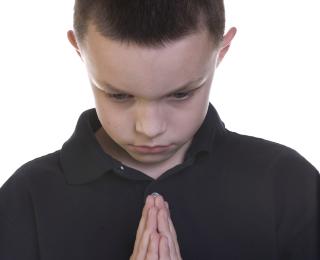Advertisement
Regardless of your personal theology—be it theist, deist, pantheist, atheist, or anything in between—as a parent you will inevitably face questions about God. Images of the divine are all around us and deeply embedded in our culture. God is mentioned in television programs and popular music, thanked by celebrities for their perceived success, and even mentioned in the Pledge of Allegiance spoken every morning in public schools across our nation.
Even if you yourself do not believe in God, or hold an image of the divine that is not anthropomorphic or close to the traditionally male father-figure of the major monotheistic religions, your child will undoubtedly form an image of such a God in his or her mind. As is the case with Santa Claus, it is not hard for children to believe since the evidence seems to be all around them. However, even very young children are able to embrace mystery surrounding the divine because they find the whole world mysterious. In fact, many children have been disappointed, hurt, and confused when their parents have given the impression that any inquires about God are unwelcome or forbidden.
Last Sunday, my family visited our local mosque as part of our Unitarian Universalist church’s religious education program, which includes units focused on learning about other religious traditions. As we were preparing to leave and return home, I was surprised to find my nine-year-old son in the worship space with his forehead pressed to the carpet as he had seen the Muslims pray. I thought he was merely imitating what he had witnessed and “trying it out” to see what it was like, but he later confessed to me that he wished we prayed at our congregation.
While I tried to explain that we did indeed engage in prayer-like activities such as meditation and spoken words which inspire connections to the divine and the universe or all humanity, he was still not satisfied. He wanted to be able to use his body to pray and humble himself in front of an all-powerful being which he could pay homage to. Once again I was humbled—apparently even I, with my supposed vast knowledge of faith development and religious education philosophy—was completely unaware that my child wanted to pray.
We have done yoga and meditation, walked a labyrinth full of wildflowers, said grace after lighting our family chalice at meals, and explored many other spiritual paths. However, the one that I neglected to introduce—and he apparently craved the most—was prayer. Because he also seemed to appreciate the kinesthetic aspects of the body prayer he witnessed, we are now exploring other traditions that utilize body prayers and working on creating our own bedtime prayer where he can express his thoughts, his longings, and his joys.
For it seems that even if you as a parent have come to conclusions that are meaningful for you, it is still necessary to teach our children that the questions they ask about the nature of the divine have not been answered to the satisfaction of a great many freethinkers and that questions about God are tough to determine because of the nature of our knowing. With maturity and physical growth, faith development also expands—and our children may expand their thinking about the divine over time, or may not. And with that, we should never make assumptions about what our children are looking for in terms of spiritual practices.
